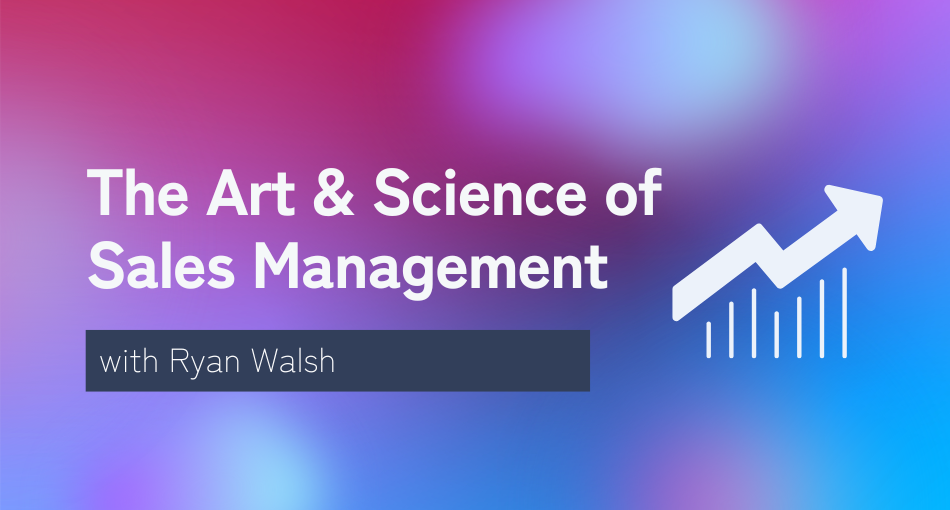 |
On this episode of the REVolution Podcast...
we talk with Ryan Walsh about the state of B2B selling and cover the hottest topics being discussed by sellers around the globe today. Topics range from how hard it is to be a first-line sales manager to the blend of art and science skills required to sell well. Ryan also shares why product market fit is critically important when considering a sales role, why you shouldn't chase high OTE (on-target earnings) alone, and what he sees for the future of B2B selling.
Listen now, check out the transcript, and subscribe
Read along with the episode transcript here or find and subscribe on your favorite podcast platform.
About our guest
Ryan Walsh is the founder and CEO of RepVue, the world’s largest crowdsourced sales team ratings platform. Prior to founding RepVue, he led GrowthLine Consulting for 6 years and had a 16 year run at ChannelAdvisor growing his scope of responsibility from sales executive to CRO (Chief Revenue Officer). Ryan works with sellers all day long and routinely shares his insights on LinkedIn.
Episode takeaways
About RepVue
We kickoff the conversation by learning more about what RepVue is and why its data is critical [2:00]. RepVue collects and aggregates socially sourced ratings from B2B sellers. It's highly data driven and not based solely on qualitative reviews like Glassdoor. The company collects data from salespeople on things other sellers care deeply about when evaluating an organization as a potential employer, like the sentiment of inbound lead flow, product market fit, professional development and training, percentage of sellers hitting quota, and average deal size. RepVue then takes all of the seller submitted information and turns it into visually appealing profiles of what it's really like to work in a specific sales organization.
The art and science of selling
Mary asks Ryan to share more about his background at ChannelAdvisor [4:45] and how hiring has challenged him in the past and how he’s solving for it at RepVue. Ryan shares that his philosophy as a seller is to focus on the art of selling first, then as a manager it focuses on the science of selling [6:20]. He suggests managers should think of it like a production line (imagine Henry Ford) and focus on driving efficiency and effectiveness. His advice when you’re early in your career is to develop your philosophy and have a mechanical system you can use to scale and grow along with your organization.
The power of network led growth
Alex asks Ryan about new channels for driving revenue and how the RepVue team thinks about growing their own business in different ways [8:58]. Ryan shares there are over 70,000 users of RepVue currently, and it’s free to sign up because employing organizations are paying customers. Traditionally, marketing dollars drive top of funnel awareness and engagement. For RepVue, awareness is 100% social because they haven’t done outbound. They always ask where sellers hear about RepVue when signing up, and it’s largely referral based. For this reason, Ryan likes to think about their strategy as being “network led growth” by and between sellers instead of the more avant-garde “product led growth”. The team at RepVue also highly focuses on growing their ecosystem bottoms up from the individual sellers. Ryan encourages everyone to think about alternative ways to drive awareness beyond the traditional top of funnel motions; he also shares how their popular t-shirts are a huge awareness driver.
How first-line sales managers impact the organization
Next, we dive into the biggest challenges for first-line sales managers [12:45]. Ryan shares that he always starts by asking whether the super rep actually wants to be a manager. He cautions leaders not to make assumptions that a great seller will always make a great manager. He also likes to probe into what the rep has done that’s made them successful and diagnose whether they can codify their practices into something that can be learned by others and scaled across the organization [14:25].
Ryan shares that the art of selling is being able to read people, react quickly in the moment, and do discovery and immediately convert it into value for the buyer. The science of selling is knowing your numbers: how much pipeline is needed, how many calls do you need to make, how many deals are needed in pipeline, and what does the close rate need to be to get there?
When evaluating individuals for manager roles, he likes to think about three questions.
- Do you have a process?
- Can you explain it clearly and mechanically?
- Will other people buy into it?
These questions are important because each manager will need to inspire a group of sellers to work together in a consistent way. The manager’s process is also likely different from the way each seller works on their own. Ryan suggests that one of the best ways to do this and get buy-in is to build organizational credibility so others are comfortable following. That comfort most often comes through showing you can generate results as an individual seller first.
The state of B2B selling
Ryan unpacks a few reasons why great sellers have trouble succeeding. It’s usually because of factors like product market fit or ineffective company leadership [19:30]. Mary mentions a statement from a teammate, Johnny, that reps often take action based on two things: what they’re paid to do and/or what their manager tells them to do [20:28]. Ryan says these two things need to be aligned. If they’re not, the organization has underlying issues with structure, compensation plans, and communication. Over the last year or so in particular, this has been a challenge because there’s been so much money flowing into companies from venture capitalists that it has been a growth at all costs mentality [22:00]. Every organization, though, reaches a tipping point where their quota capacity surpasses their TAM (total addressable market). The question you need to ask as a potential seller is whether that organization has also added more to their product features that expands the overall market. If it hasn't, it's likely going to become increasingly difficult to succeed.
What’s happened with sellers recently is that you don’t always know what’s going on with TAM. As a result, quota attainment has gone down along with seller retention. We’re now at a tipping point between quota coverage and TAM/product market fit in many organizations. Ryan shares that many companies get upside down somewhere as the company scales and that it’s important for sellers to understand the market and product market fit through the lens of whether you can keep developing product features fast enough to continue expanding your share wallet over time or if you’re going to get upside down.
Product market fit reigns supreme
Alex asks Ryan for his thoughts on whether first-line sales managers are the most important within an organization [25:50]. Ryan says it’s an important position, but he counters the suggestion with a quote: “if you throw a great management team at a bad product, the product wins every time.” He says you can have a great manager and be happy, but perhaps you get to the tipping point mentioned above or maybe you get into a crappy territory. It makes it really hard to win. You could also have a bad manager, but you’re in an awesome territory with a great product and you’re still growing and you’ll want to stick around. Stack ranking positions in order of importance within an organization is very hard and they’re all important. Ryan says sellers believe product market fit is the number one most important thing in choosing a great organization to work in.
Declining quota attainment
Mary asks about trends on quota attainment and Ryan says right now fewer reps are hitting quota in the last six months across all segments [28:52]. He shares that it’s problematic, but typical in most companies. Then, he dives into an example of all the buffer that gets added in at each layer of the selling organization (from individual to first-line sales manager and above). The buffer typically always exists and in the example he shares the padding could be as much as $12 million between leader and individual sellers. The challenge with this much buffer is from a human aspect. As a sales leader, you want your people to win and if you get too far away from thinking about each person as an individual, issues pop up. Ryan suggests that sales people will recognize their leaders' ultimate motivation; therefore, it’s critical to not have too much buffer in there and to want to make as many sellers successful and hitting quota as possible.
Hindsight is 20/20
Alex asks Ryan to share what his biggest challenge was and what he’d do differently now [34:00]. The answer to that from Ryan was attrition and he shares that his sense of clarity now is way better having stepped back a bit. It’s always hard to lose people and you always wonder what you could have done differently to keep them. Ryan’s advice is to really understand what’s happening under your nose as a manager and leader and to ask yourself hard questions and reflect on what people say when they leave.
Don't go chasing high OTE
Mary asks Ryan about what he’s seeing in the data in the current market regarding OTE and whether reps might not be chasing the monstrous payouts as much as they were compared to looking for more security and higher base pay [36:12]. In the past, Ryan says a lot of people were chasing high OTE and that it’s really meaningless if you can’t achieve the number. Instead, it’s more like FauxTE or off-target earnings if only 30% of reps are hitting it. Ryan then talks about when you hit the wall where you can’t grow anymore [37:45] and you still have a big OTE and people aren’t hitting it and layoffs kick in. To avoid this scenario, he suggests you not get too distracted by the numbers alone when making decisions on where to work, instead take a lot into consideration including product market fit.
The future of B2B sales
Ryan sees the biggest factor that’s going to influence B2B selling as the way sellers research the product they're considering selling [39:50]. In the past, there was a lot more comfort that if you signed up for a role that you would be able to sell the product. For him, what’s top of mind now is helping sellers research what they’re going to sell in detail and being sure it’s a good fit. He says there’s always going to be a need for sellers and that product led growth won’t change that. Humans want to connect with other humans, deals are complex, and someone needs to shepherd it within the organization.
Alex asks Ryan more about product led growth (PLG) and sales-assisted versus sales-directed motions [41:15]. For RepVue, Ryan sees the awareness part of their funnel through the network led growth motion mentioned earlier. A lot of companies don’t yet have this though, unless they’re a massive company with a lot of resources. He says PLG is phenomenal and he loves the trend, but understand it gets complicated with metrics around PLG and how you report on whether it’s working for your organization or not.
Mary mentions that 70% of the buyer's journey is online now and we talk about revenue as a team sport [45:00]. She asks whether Ryan sees the roles on the team as changing and cites Forrester’s latest prediction that demand marketing is going to report into sales more than ever starting in 2023. Ryan says he’s in full support of the team sport concept, but that if demand marketing is reporting into sales, it’s now revenue not marketing. Instead, what sellers should say is that they want good, quality leads as far down the funnel as possible. The question for organizations is how far can marketing push the demand down the funnel? Ryan says all of this needs to be balanced based on many factors and that growth is a company sport, not just a revenue team sport. Mary then asks whether he thinks other teams will get compensated for driving growth [48:00], and he says he’s a fan of as many people getting compensated directly based on revenue goals as possible. The challenge in this most often is that alignment suffers when teams are measured and compensated on different things [49:35].
Conversation wrap-up
We then start to wrap up the conversation by talking about how C-level people can get "squirrely" when they have to write huge commission checks. Ryan says that happens a lot, especially when that executive hasn’t been in sales before [51:00]. Ryan and Alex then talk about why having a sales background is a great foundation for being a senior executive or founder and Ryan shares that he’s always excited to see sellers become founders.






%20(4)-1.png)